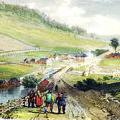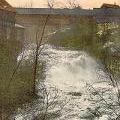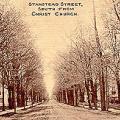 THE THREE VILLAGES
THE THREE VILLAGES
Created in 1995 out of the former "Three Villages" of Stanstead Plain, Rock Island, and Beebe Plain, Stanstead is today one of the most historic and picturesque towns in the Eastern Townships. Located on the Quebec-Vermont border, the community was settled in the 1790s. The first family to arrive were the Taplins, who settled in 1796. The Taplins were like virtually every other pioneer family of that era. They came to Stanstead from New England. And they were looking for good land, which was becoming scarce in the new American republic.
The Taplins came to a country that was a complete wilderness. They were not alone for long, however, for they were soon followed by other families. The names of some of those families are still reflected in local place names: Pierce, Lee, Beebe, and others.
Stanstead was for some time an isolated backwater, the haunt of smugglers. A customs port was established here in 1821, the first in the Townships, and that helped. But some years later, officials were still complaining that Stanstead was"a community where smuggling is popular and the population is shrewd and lawless and ever willing to aid smugglers."
THE STAGECOACH
Be that as it may, Stanstead blossomed in the 19th century. Growth and prosperity were everywhere. Where once there were forests were now wide streets with elegant homes, inns, and prosperous businesses. A major advantage to the economy was the stagecoach, which linked Quebec City and Montreal with Boston. So, early in its history, Stanstead took on the role of transportation centre, a role which, due to its strategic location on the border and its proximity to Autoroute 55, it retains to this day.
 TOMIFOBIA RIVER
TOMIFOBIA RIVER
Another advantage was the Tomifobia River, which winds its way through town, and whose thundering falls are still an impressive site. The Tomifobia gave birth to some of the first mills in the Townships. In 1803, Colonel Charles Kilborn built grist and saw mills in what is now the Rock Island part of town, and for many years that settlement was known as "Kilborn's Mills." The river, whose current powered the first waterwheels in town, would in time power a whole string of factories all the way down through the village. These shops, which manufactured everything from whips to overalls to tools, would transform Rock Island into an important industrial town. These were boom times for the village: full employment, and fortunes being made. The Butterfield Tool factory, which was built directly astride the border, and which at its peak employed hundreds of workers from both sides of the line, may still be seen today.
GRANITE CAPITAL OF CANADA
When people think of Stanstead, they sometimes think of its only indigenously named "species": Stanstead Grey Granite. This stone, which is quarried in and around Beebe, began to be worked on a large scale in the late 1800s. It would grow to become the cornerstone of the local economy, the rock, as it were, upon which Stanstead is built.
During the Great Depression of the 1930s, it was granite that kept the town going, for the largest office building in the British Empire, Sun Life of Montreal, was going up, and it was built entirely of Beebe granite! Today, granite and related industries employ hundreds of workers in Stanstead. The town, in fact, is referred to as the "Granite Capital of Canada."
 BOOMTOWN
BOOMTOWN
There were other reasons for Stanstead's prosperity. Long before the honour went to Magog, Stanstead was the seat of county government. A seminary was built here in 1829, eventually becoming Stanstead College, now a renowned private school. A second private school, the French Collège des Ursulines was built in 1881. It too is an important part of the community. The registry office was established here in 1839, and here it remains to this day. The Stanstead Journal has served the community since 1845, making it the oldest weekly paper in the province of Quebec. The Eastern Townships Bank opened a branch in Stanstead in 1859, one of the first banks in the Townships. And with the growth of commerce and industry saw yet another arrival: the railroad. The whistle of a steam locomotive in 1870 signalled the arrival of the Massawippi Valley Railway, which in later years became the Quebec Central.
That, of course, was long ago, and things have changed. The stagecoach is long gone. So too are the railways and many of the factories. Yet, many things remain that are both reminders of Stanstead's colourful past and signs of its promising future. For instance, the railwaysmay have disappeared, but the old tracks have been transformed into a bicycle path that winds its way right through town.
The disastrous fire that wiped out the north end of Dufferin in 1915 may have changed the look of that part of town. But most of the homes were quickly rebuilt, and some of them were even more splendid than their predecessors. The granite industry is bigger than ever. Dufferin Street and Principale in Beebe are still just as beautiful as they always were. Rock Island is still the commercial centre it always was. And the border is still a major part of local life -- as evidenced by Border Fest, which takes place here each year.